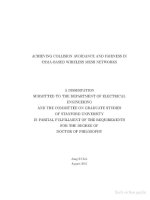Wireless networks - Lecture 32: Wireless mesh networks (Part 2)
Bạn đang xem bản rút gọn của tài liệu. Xem và tải ngay bản đầy đủ của tài liệu tại đây (683.89 KB, 29 trang )
Wireless Networks
Lecture 32
Wireless Mesh Networks Part II
Dr. Ghalib A. Shah
1
Outlines
MAC Layer
►
►
►
►
►
Scalability
Single Channel
Multi-Channel
Some Ideas
Research Issues
Network Layer
►
►
►
►
►
Routing
Wish List
Route Optimization Criteria
Routing fairness
Routing – Cross-layer design
QoS Support at each layer
WMN Standards
2
Last Lecture
Introduction to WMN
Characteristics
WMN vs MANET
Architecture
Applications
Critical factors influencing performance
► Radio techniques, scalability, QoS, security, Ease of
Use, Mesh connectivity
3
MAC Layer
MAC for WMNs is concerned with more than
one hop communication.
MAC is distributed and cooperative and works
for multipoint-to-multipoint communication.
Network self-organization is needed for the
MAC.
Mobility affects the performance of MAC
4
The scalability of MAC can be addressed in two
ways.
► Enhance the existing or propose new for single
channel to increase E2E throughput
► Allow transmission on multiple channels of each
network node
5
Basic Techniques
Scheduled
► Fix scheduled TDMA
► Polling
► Impractical due to lack of:
• Central coordination point
• Reasonable time synchronization
Random Access
► CSMA – simple and popular
► RTS/CTS – protects the receiver
6
c
f
Channels can be
implemented by:
►
►
►
►
c
t
f
FDMA
CDMA (code assignment is
an issue)
SDMA (with directional
antennas)
Combinations of the above
t
c
c
t
f
c
t
s1
f
s2
f
c
t
t
s3
c
f
t
7
f
Single channel MAC
Improving existing MAC protocol
►
►
Cross-layer design with advanced physical layer.
►
By changing parameters of CSMA/CA based MACs like contention
window size and backoff procedures for multi-hop.
Contention based approaches are not scalable and throughput
degrades with increase in contention.
MAC based on directional antenna and power control
Innovative solutions
►
►
►
Need new ideas to overcome low end-end throughput for multi-hop ad
hoc environment.
TDMA or CDMA based MAC needs to be explored.
Compatibility, cost and complexity are the important factors in
designing new protocols
8
MAC – Multichannel Why?
Increases network capacity
2
Ch-1
1
2
Ch-1
-1
Ch
1
3
-2
Ch
2
3
4
Ch-1
User bandwidth = B/2
4
1
3
Ch-2
User bandwidth = B
Chain bandwidth = B
B = bandwidth of a channel
9
MAC – Multichannel
MCCL
802.11
PHY
Ch-1
3
2
-2
Ch
4
IP
-1
Ch
Perhaps, if a new MultiChannel Coordination Layer
(MCCL) is introduced between
MAC and Network
Must work within the
constraints of 802.11
May increase the capacity of
the network
1
2
Ch-2
1
3
10
Multi-channel MAC (MMAC)
Multi-channel single transceiver
► One channel active at a time
► Different nodes may operate on different times.
► Hence, coordination is required
Multi-channel multi-transceiver
► A radio includes multiple parallel RF chips and baseband
processing modules to support several simultaneous channels.
► On top of multiple channel in physical layer, only single MAC to
coordinate operations.
Multi-radios MAC
► A node has multiple radios each with its own MAC and
physical.
► A virtual MAC protocol such as a multi-radio unified MAC
protocol is required to coordinate communication among all.
11
MMAC Functions
Maintaining data structure of all channels in each node.
► classified into three types depending on its status of allocation.
Negotiating channels during ad hoc traffic indication
message (ATIM) window.
► Negotiations are done through a pre-defined channel known to
all nodes.
Selecting a channel.
► The criterion is to use a channel with the lowest count of
source–destination pairs that have selected the channel.
12
Multi-radio Unification Protocol
Discovering neighbours.
► After the discovering procedures, neighbors are classified into
MUP enabled and legacy nodes.
Selecting a NIC
► based on one-hop round trip time (RTT) measurements. MUP
selects the NIC with the shortest RTT between a node and its
neighbors.
Utilizing the selected NIC for a long period.
► This period is determined by a random process and in the
order of 10–20 s.
Switching channels.
► After the random time period, all NICs are measured again
through one-hop probe messages. If an NIC has a certain
amount of quality improvement than the existing NIC, then it is
selected for sending packets.
13
Open research issues
Scalability issue in multi-hop ad hoc network has not been solved
yet.
CSMA/CA based MAC protocols solve partial problems
A distributed TDMA or CDMA MAC can be the solution.
Mesh routers and clients hold different characteristics like mobility,
power consumption etc.
A single solution may not be applicable for both.
Some Mesh routers integrate various wireless networking
technologies and require advance bridging functions
Existing research focuses on capacity, throughput and fairness.
But many applications may require broadband multimedia
communication in WMNs.
MAC developed with QoS metrics
14
Network Layer
WMN will be tightly coupled with internet and IP
has been widely accepted in different wireless
networks.
However routing differs from IP and cellular.
15
Routing
Finds and maintains
routes for data flows
The entire performance of
the WMN depends on the
routing protocol
May be the main product
of a mesh company
May be missing
16
Routing – Wish List
Scalability
►
►
Overhead is an issue in
mobile WMNs.
Fast route discovery and
rediscovery
►
Essential for reliability.
Flexibility
QoS Support
►
Mobile user support
►
Seamless and efficient
handover
Consider routes satisfying
specified criteria
Multicast
►
Work with/without gateways,
different topologies
Important for some
applications (e.g.,
emergency response)
17
Existing Routing Protocols
Internet routing protocols Ad-hoc routing protocols
(e.g., OSPF, BGP,
(e.g., DSR, AODV,
RIPv2)
OLSR, CBR, TORA)
► Well known and trusted
► Designed on the
assumption of seldom link
changes
► Without significant
modifications are
unsuitable for WMNs in
particular or for ad hoc
networks in general.
Ad Hoc
Networks
► Newcomers by
comparison with the
Internet protocols
► Designed for high rates of
link changes; hence
perform well on WMNs
► May be further optimized
to account for WMNs’
particularities
Wireless Mesh
Networks
18
Routing - Optimization Criteria
Minimum Hops
Minimum Delays
Maximum Data Rates
Minimum Error Rates
Maximum Route Stability
Power Consumption
Combinations of the
above
Use of multiple routes
to the same gateway
Use of multiple
gateways
19
Routing – Cross-Layer Design
Routing – Physical
►
►
►
Link quality feedback is
shown often to help in
selecting stable, high
bandwidth, low error rate
routes.
Fading signal strength can
signal a link about to fail →
preemptive route requests.
Cross-layer design essential
for systems with smart
antennas.
Routing – MAC
►
►
►
Feedback on link loads can
avoid congested links →
enables load balancing.
Channel assignment and
routing depend on each
other.
MAC detection of new
neighbors and failed routes
may significantly improve
performance at routing layer.
20
Routing – Cross-Layer Design (cont)
Routing – Transport
► Choosing routes with
low error rates may
improve TCP’s
throughput.
► Especially important
when multiple routes
are used
► Freezing TCP when a
route fails.
Routing – Application
► Especially with respect of
satisfying QoS constraints
21
Network Layer - Fairness
Fairness
►
►
Horizontal – nodes 1, 2
►
Equal share of resources to
all participants.
Special case of priority
based QoS.
GW
2
1
The MAC layer’s fairness
ensures horizontal fairness.
Vertical – nodes 3, 4
►
MAC layer is no longer
sufficient
GW
3
4
22
Fairness Problem
G
2
G
S2
Unfair
Inefficient
1
S1
Ideal
GW
Real
23
QoS Support required at every layer
Physical Layer
►
►
MAC Layer
►
►
Robust modulation
Link adaptation
Offer priorities
Offer guarantees (bandwidth,
delay)
Transport
►
Attempt end-to-end recovery
when possible
Application
►
►
Negotiate end-to-end and
with lower layers
Adapt to changes in QoS
Network Layer
►
►
►
Select “good” routes
Offer priorities
Reserve resources (for
guarantees)
24
WMNs Standards
WPAN: Bluetooth, Zigbee
WiFi: 802.11a, b, g, n
WiMAX: 802.16
Range
50Km
100m
WiMAX
WPAN
100kb 1Mb
WiFi
10Mb
100Mb
25 Data Rate









